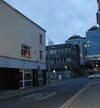What would become of the Civic Offices on Wood Quay if the council relocates?
After The Currency reported the idea of the council moving its HQ, councillors were talking about and thinking through the pros and cons and implications.
As part of the IN PLACE project, 13 artists will work in or around vacant city-centre sites, creating works that fit their surroundings.

While they lie empty, you might as well make art.
So reckons Nichol Gray and a collective of like-minded creatives involved with the IN PLACE art project throughout the month of September.
The idea behind the project, Gray says, is to address Dublin’s vacant spaces, “by [posing] questions about the way we are influenced by disused urban space”.
Thirteen artists will work either in or around a number of vacant city-centre sites over the next four weeks, creating works that fit the surroundings.
Project curator Gray says that she and others decided to address, artistically, the panoply of vacant sites across the city.
“A lot of us had had the idea, literally from just walking through the city and being constantly reminded of the amount of vacant spaces,” says Gray. “We sat down to decide how to formulate a response.”
Working with event organisers Connect the Dots, Gray and her collective have occupied a vacant space on Tara Street for four weeks, with permission from the landlord. They intend to turn it into an art gallery.
An exhibition of the works that artists have done in vacant sites across the city will take place there a month from now, opening on 29 September.
Each artist has been given free rein in choosing their vacant space, and with no prescription, any medium goes. Paintings, sculptures and installations.
For the event, some works may have to be scaled down. “I think the artists are making the work with that in mind though, that it will eventually be brought to a gallery space,” says Gray. “These aren’t going to be huge, large-scale, installation pieces.”
So far, four artists have been tasked with altering, through art, the Tara Street space.
Others have chosen two warehouses in East Wall. One has honed in on the old John Player Factory on Donore Avenue in Dublin 8. And yet another has opted for the long-locked, but soon to be revamped, Peace Park opposite Christ Church.
The fact that many of the sites are locked, fenced, or walled, has been a challenge for Gray and her team.“It absolutely has been a huge problem and one I knew would be at the forefront of the project from the get-go,” she says.
The group did talk to the city council, the heritage council, and the Office of Public Works. But “that has not really yielded us any sites”, said Gray. So bypassing permission has become part of the project.
“I’m pursuing, as far as I possibly can, legitimate avenues of acquiring space, but it’s not always possible,” she says. “That’s something we’re including in the dialogue of the project as well: who owns these spaces, who has rights of access to them and why.”
Connect the Dots co-founder Marisa Denker says the project appealed to the group as a sort of shared interest.
“We’ve been doing events for about a year and a half, and a lot of them had to do with vacant space,” she says. “At the IN PLACE [launch] we presented all we’d gathered over that time.”
By pointing to policy documents and data, Denker and Gray hope to combine the vacant site artworks with more-concrete information that might help push solutions.
“There are very successful policy initiatives in other European countries that have led to a huge decrease in vacant sites,” says Gray. “Connect the Dots are going to help us with that, pointing to the solutions available.”
The group of artists, including Jordan McQuade and Shane McCormack, is also producing a photo book so that exhibition visitors have something to take away.
The exhibition will run until 3 October, at 6 Tara Street, beside Mulligan’s pub. You can find IN PLACE here on Facebook and Instagram.